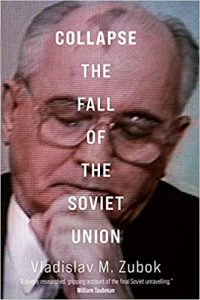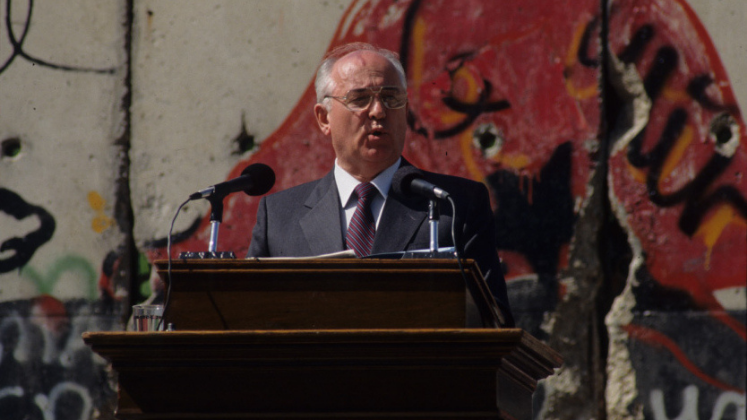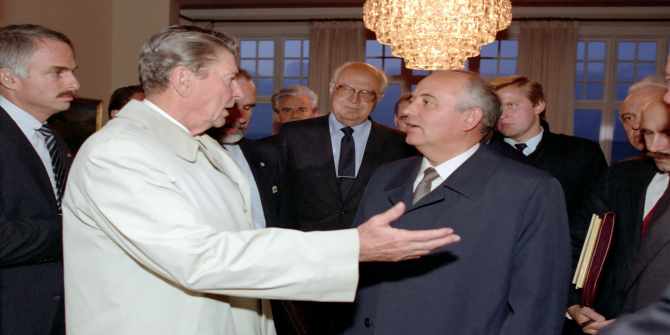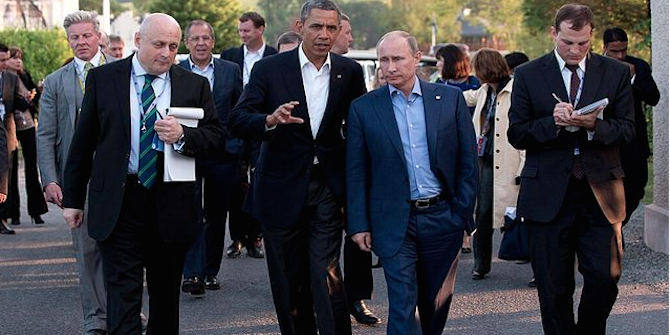In Collapse — winner of 2022 Reginald Zelnik Book Prize in History and shortlisted for 2022 Cundill History Prize— Vladislav M. Zubok examines the fall of the Soviet Union, showing how the collapse was not sudden but rather the result of a long decline with economic strains at the centre. This is a compelling and detailed study that will prove to be the new standard work on a critical period in world history that still has ramifications today, writes William B. Whisenhunt.
This book review has been translated into Mandarin by Tom Abram (LN814, teacher Dr Lijing Shi) as part of the LSE Reviews in Translation project, a collaboration between LSE Language Centre and LSE Review of Books. Please scroll down to read this translation or click here.
Collapse: The Fall of the Soviet Union. Vladislav M. Zubok. Yale University Press. 2021.
 The collapse of the Soviet Union in 1991 was once part of current events, but now it is history. The last years of the Soviet Union were tense and controversial. The 1970s and 1980s were defined by the idea of Mutually Assured Destruction (MAD), Cold War movies like The Day After, War Games and Red Dawn, economic stagnation and heated rhetoric from figures like the Soviet Union leader, Yuri Andropov, and US President Ronald Reagan. For those who lived through this era, the dread of apocalyptic disaster was mixed with dark cynicism about the period’s politics.
The collapse of the Soviet Union in 1991 was once part of current events, but now it is history. The last years of the Soviet Union were tense and controversial. The 1970s and 1980s were defined by the idea of Mutually Assured Destruction (MAD), Cold War movies like The Day After, War Games and Red Dawn, economic stagnation and heated rhetoric from figures like the Soviet Union leader, Yuri Andropov, and US President Ronald Reagan. For those who lived through this era, the dread of apocalyptic disaster was mixed with dark cynicism about the period’s politics.
With Collapse, esteemed historian Vladislav M. Zubok has written what will prove to be the new standard work on one of the most dramatic events of the late twentieth century. The collapse of the Soviet Union in late 1991 seemed sudden to the world, and even a bit unbelievable. Yet, Zubok illuminates how the collapse was not so sudden, but rather the result of a long decline.
Zubok’s book takes a novel approach to the subject by focusing on economic strains as the main cause of the collapse. Economic stagnation from the 1960s and 1970s has often been discussed in other works on the last years of the Soviet Union, but Collapse puts that theme front and centre. After reading Zubok’s lengthy study, the economic argument becomes more and more compelling. While traditional interpretations still hold up over time, this work makes it clear that the main strain was economic.
This economic theme falls squarely on the shoulders of the final leader of the Soviet Union, Mikhail Gorbachev. His economic reforms, known as perestroika (‘restructuring’), were slow to develop and did not produce the kind of change that allowed the Soviet economy to modernise. His openness policy, known as glasnost, allowed Soviet citizens to see that world in a new way, but it also exposed a lot of the flaws of the Soviet regime in the past and present. This bred an impatience among Soviet citizens to fulfil the long-held Soviet promise of better living standards, but these did not materialise.

Image Credit: ‘End of Cold War – Mikhail Gobachev Event’ by Photographer/Studio SW licensed by Missouri State Archives, No Known Copyright Restrictions
Zubok’s lengthy and detailed study is easy to read. It is crafted with a strong narrative approach to relate an unfolding drama. This not only keeps the reader’s attention, but also provides a wealth of detail and analysis that can only be undertaken by someone with Zubok’s lifetime of work on the subject.
The first section of the book focuses on the 1980s when the Soviet Union was declining as it went through a series of older and sick leaders before Gorbachev came to power in March 1985. For both the general reader and the specialist, this section is very important. It draws the reader into the details of the drama that shaped not only the internal collapse of the Soviet system, but also outlines how the outside world (especially the United States) played a key part in how this era developed.
In the second section, Zubok emphasises the roles that many Western powers played in the collapse of communism in Eastern Europe in 1989. The intimate details Zubok reveals about the conversations and negotiations that took place between 1989 and 1991 are a treasure in this work and will be used by scholars for years to come.
In particular, the administration of US President George H.W. Bush (1989-93) played a critical part in the unravelling of the Soviet Union with its desire to have it end peacefully rather explode into a regional or international conflict. While the Bush administration was hesitant in the first half of 1989 to engage fully with Gorbachev, it would prove central to the events that led to the dissolution of the Soviet Union in the last months of 1991.
One of the most compelling parts of the books is Zubok’s retelling and analysis of the period between August and December 1991. The details are revealing about the inner workings of the Soviet government in its final days and weeks. The future first President of the Russian Federation, Boris Yeltsin, emerges in this treatment as a pivotal figure who saw the changes that were coming and positioned himself to take advantage of them for his own personal power. Also, hardline communists in the leadership presented roadblocks at nearly every turn to Gorbachev’s reforms that left his attempts at transformation quite anaemic.
Zubok concludes, though, that the real responsibility for the collapse rests on Gorbachev. He introduced radical economic reforms that could not be fulfilled. He stresses that Gorbachev’s inability to adjust to the developing realities during his six years in power helped spread disillusionment with the system itself. Gorbachev’s inspiration for this reform effort was the work of the Soviet founder Vladimir Lenin. However, he only partially embraced Lenin’s tactics to bring about such radical change. Zubok’s conclusion about Gorbachev is telling. He notes that Gorbachev’s ‘messianic idea of a humane socialist society was increasingly detached from the realities of Soviet power and its economy’ (427).
In conclusion, Zubok’s book is an excellent study of this critical period in world history that still has ramifications today. His research and analysis will prove invaluable for scholars and the general public as they attempt to understand the collapse of 1991 and its continuing impact on the present.
Note: This review gives the views of the author, and not the position of the LSE Review of Books blog, or of the London School of Economics and Political Science.
Banner Image Credit: Photo by Tengyart on Unsplash
《崩溃》一书,在2022年获得 Reginald Zelnik 历史书籍奖,并进入2022 Cundill 历史奖短名单。在《崩溃》中,弗拉迪斯拉夫·祖博克 (Vladislav M. Zubok) 分析了苏联解体,揭示了苏联崩溃并非突然发生,而是经济长期衰退的结果。 William B. Whisenhunt 评论说: 这部有力详细的研究将会变成关于世界历史紧要时期的又一本重要新著作。
《崩溃: 苏联的解体》。弗拉迪斯拉夫·祖博克(Vladislav M. Zubok) 。耶鲁大学出版社。 2021
 1991年的苏联解体曾经是时事的一部分,而如今已经成为了历史。苏联的最后几年紧张又充满争议。 1970与1980年代的界定元素包括相互保证毁灭的概念ˎ 冷战电影诸如 《那天以后》 (The Day After) 《战争游戏》 (War Games) 及《赤色黎明》 (Red Dawn)ˎ 经济停滞ˎ 以及并当时名人的激烈修辞如苏联领导安德洛波夫 (Yuri Andropov) 或美国总统雷根 (Ronald Reagan) 。对经过那个时代的人来说,世界末日灾害的恐惧跟对政治的黑暗犬儒主义混杂了在一起。
1991年的苏联解体曾经是时事的一部分,而如今已经成为了历史。苏联的最后几年紧张又充满争议。 1970与1980年代的界定元素包括相互保证毁灭的概念ˎ 冷战电影诸如 《那天以后》 (The Day After) 《战争游戏》 (War Games) 及《赤色黎明》 (Red Dawn)ˎ 经济停滞ˎ 以及并当时名人的激烈修辞如苏联领导安德洛波夫 (Yuri Andropov) 或美国总统雷根 (Ronald Reagan) 。对经过那个时代的人来说,世界末日灾害的恐惧跟对政治的黑暗犬儒主义混杂了在一起。
备受尊重的历史学家祖博克的《崩溃》将会变成关于二十世纪末最戏剧化大事之一的新基准著作。1991年底的苏联解体貌似毫无征兆, 甚至难以置信。 然而祖博克指出苏联解体并非突然,却是长期衰退的结果。
此本书以经济张力为崩溃的主因,手法新颖 。从60至70年代的经济停滞已被其他关于苏联末年的书籍广泛谈论,然而《崩溃》将之推至前台,作为全书的核心。读完祖博克长篇研究之后,发现其经济论点越来越有力。即使传统解释还有效,但此部著作明确指出经济是主要的压力来源。

经济主题就落在最后苏联领导戈尔巴乔夫(Gorbachev) 的肩上。 他采取的经济改革称为perestroika, 意即“重建”。 但执行的进度缓慢, 也没产生导致经济现代化。 他称为glasnost的开放政策让苏联公民从新角度来看世界,却也显出许多苏联政权的今昔缺陷。 此举令人更期待长期以来改善生活水平的承诺; 但这些承诺最终没有被履行。
祖博克的研究虽然篇幅长 、细节多,却易于阅读。 它工于叙事形式,讲与主题有关的故事徐徐道来。不仅保持读者的关注,也供应丰富的细节与分析。只有像祖博克一辈子都研究这个主题的学者才能做到。
此本书的第一部分聚焦1980年代。在1985年5月戈尔巴乔夫上台之前,苏联被一连串又老又病的领导统治。同时苏联已经开始没落了。从普遍读者和专家的角度来看, 这个部分十分重要。它详细地叙述苏联系统内的崩溃,并解释外界,特别是美国,在这段时期的扮演了什么重要角色。
第二个部分着重描写1989年许多西方势力在东欧共产主义的崩溃中扮演的角色。 从1989及1991年的谈话和谈判展示的细节就是这本书的宝藏,今后也一定继续被学者利用。
美国总统乔治·沃克·布什(George W. Bush) 政府在苏联的瓦解有扮演特别重要的角色。 布什有意思苏联安稳地结束,不希望它引发区域或世界战争。 虽然1989年上半年布什政府还在犹豫是否与苏联合作,在引向苏联1991年底瓦解的所有大事,美国都起了关键作用。
祖博克对于1991年8月至12 月时期的叙述及分析是最雄辩的部分之一。详细显出苏联政府最后日子的内部运作。祖博克的描绘将后来出任俄联邦第一任总统鲍利斯·叶利钦 (Boris Yeltsin) 呈现为关键人物。他预见到了将来的变迁,并为了个人势力而利用这种变迁。此外,领导层中的强硬共产主义者阻止几乎所有戈尔巴乔夫的改革,导致其改变的计划很受局限。
祖博克总结指出苏联解体的现实责任仍然落在了戈尔巴乔夫的肩膀。戈尔巴乔夫推出了无法履行的激进改革。作者强调,由于戈尔巴乔夫无法顺应六年任期之内的新现实状况,扩散了人民对系统的理想幻灭感。戈尔巴乔夫改革的启示起源于列宁(Lenin),这位苏维埃祖师的书籍。不过他却有限地采行这些列宁的策略,导致激进变化。祖博克关于戈尔巴乔夫的结语很有道理。他指出戈尔巴乔夫的 “人道社会主义的这个救世主的思想越来越脱离苏维埃的权力与经济的实际情况” (427)。
总之,祖博克的著作是关于那个世界历史关键时期的优秀研究。该时期对现今还有深远的影响。对想了解1991解体及其持续影响的学者或普通公众而言,祖博克的研究跟分析将会成为无价之宝。








thanks for your review! that is very helpful. looks forward to more reviews of books related to soviet union and russia